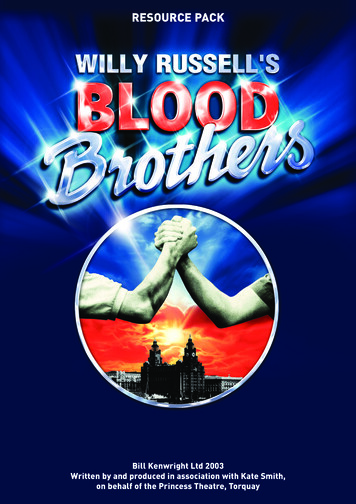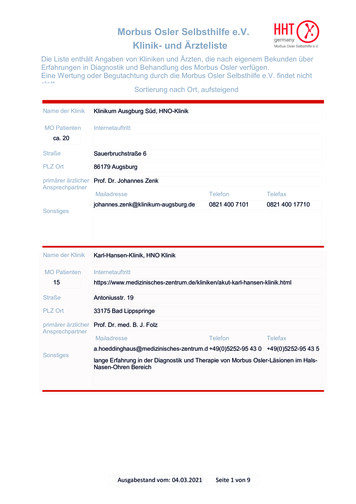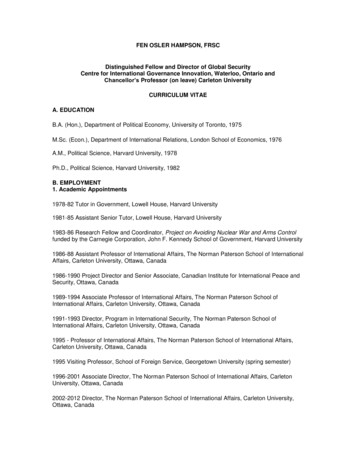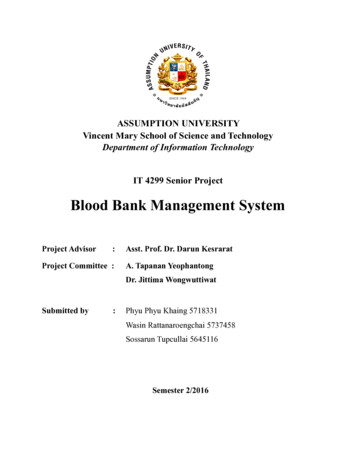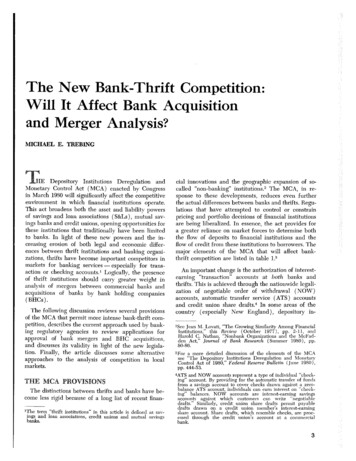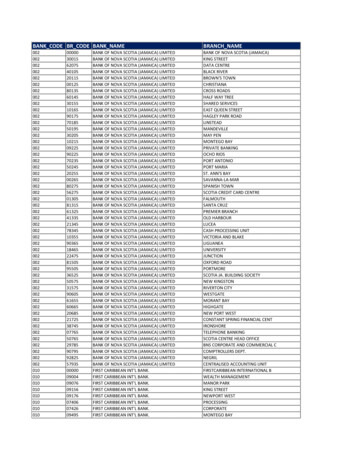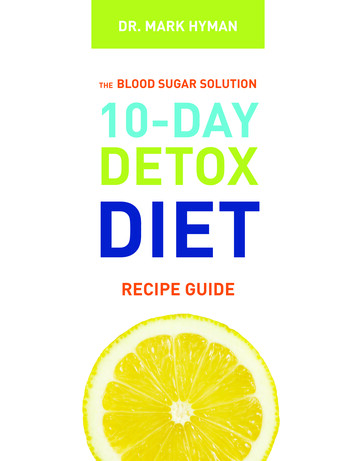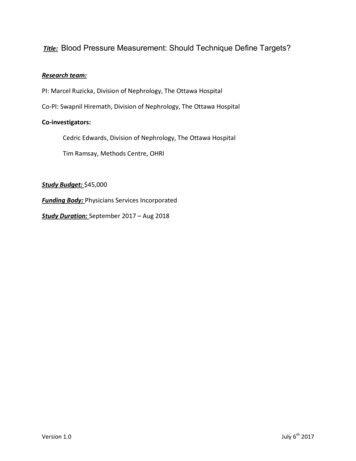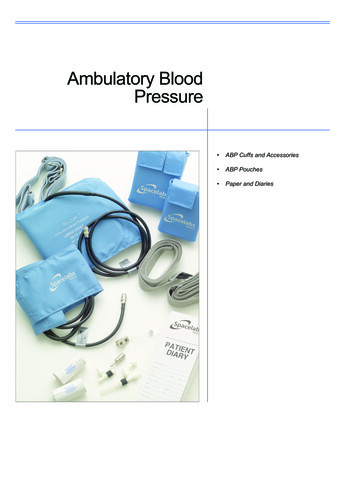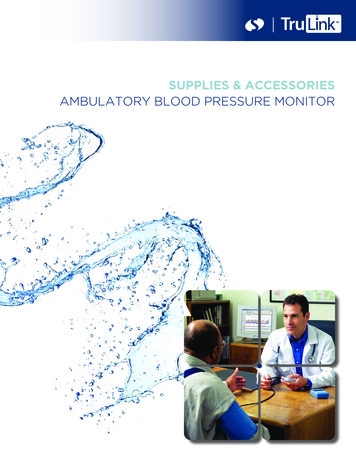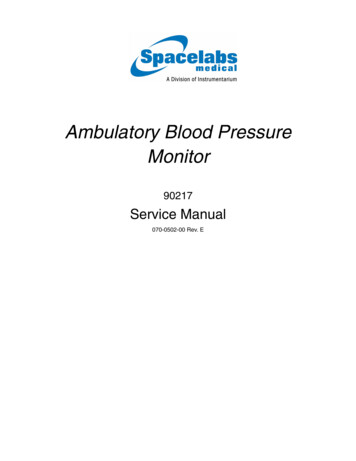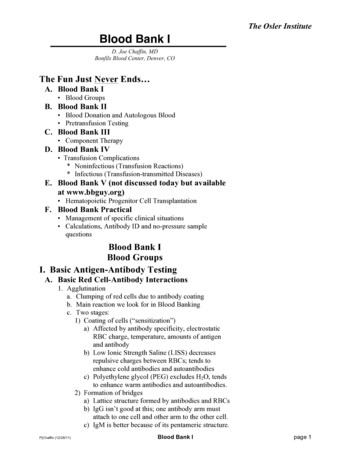
Transcription
The Osler InstituteBlood Bank ID. Joe Chaffin, MDBonfils Blood Center, Denver, COThe Fun Just Never Ends A. Blood Bank I Blood GroupsB. Blood Bank II Blood Donation and Autologous Blood Pretransfusion TestingC. Blood Bank III Component TherapyD. Blood Bank IV Transfusion Complications* Noninfectious (Transfusion Reactions)* Infectious (Transfusion-transmitted Diseases)E. Blood Bank V (not discussed today but availableat www.bbguy.org) Hematopoietic Progenitor Cell TransplantationF. Blood Bank Practical Management of specific clinical situations Calculations, Antibody ID and no-pressure samplequestionsBlood Bank IBlood GroupsI. Basic Antigen-Antibody TestingA. Basic Red Cell-Antibody Interactions1. Agglutinationa. Clumping of red cells due to antibody coatingb. Main reaction we look for in Blood Bankingc. Two stages:1) Coating of cells (“sensitization”)a) Affected by antibody specificity, electrostaticRBC charge, temperature, amounts of antigenand antibodyb) Low Ionic Strength Saline (LISS) decreasesrepulsive charges between RBCs; tends toenhance cold antibodies and autoantibodiesc) Polyethylene glycol (PEG) excludes H2O, tendsto enhance warm antibodies and autoantibodies.2) Formation of bridgesa) Lattice structure formed by antibodies and RBCsb) IgG isn’t good at this; one antibody arm mustattach to one cell and other arm to the other cell.c) IgM is better because of its pentameric structure.P}Chaffin (12/28/11)Blood Bank Ipage 1
Pathology Review Course2. Hemolysisa. Direct lysis of a red cell due to antibody coatingb. Uncommon, but equal to agglutination.1) Requires complement fixation2) IgM antibodies do this better than IgG.B. Tube testing1. Immediate spin phasea. Mix serum, 2-5% RBC suspension; spin 15-30 sec.1) Most common: 2 drops serum, 1 drop RBCs.b. Antibodies reacting here are usually IgM2. 37 C phasea. Add potentiator ( /-), incubate at 37 C, spin.b. Potentiators and incubation times:1) 10-15 minutes for LISS2) 15-30 minutes for albumin or PEG3) 30-60 minutes for no potentiation3. Indirect antiglobulin (“antihuman globulin”) phasea. Wash above to remove unbound globulins.b. Add antihuman globulin, spin.C. Alternatives to tube testing1. Column agglutination technology (Gel testing)a. Add RBCs and plasma to top of tube, incubate, spin.b. Microtubes are filled with gel particles and anti-IgG1) Anti-IgG grabs onto IgG-coated RBCs and inhibitstheir migration through gel immunologically2) Gel particles separate RBC clusters physically(inhibit agglutinates from migrating through gel).c. Results:1) Negative: RBCs form button at bottom ofmicrotube.2) Positive: RBCs stopped in areas through themicrotube (more positive higher position in tube)d. Can be automated (ProVue machine)e. Similar sensitivity to PEG tube testing2. Solid-phase Red Cell Adherence Testinga. Antibody binds to lysed or intact RBC antigens thatare bound by manufacturer to the sides of microwellsb. Add patient serum, incubate, wash: If positive,antibody binds to test RBCs.c. Indicator RBCs (coated with monoclonal anti-IgG)attach to antibody on test RBCs.d. Spin and interpret1) Negative: RBCs in a button at bottom of microwell,(indicator cells didn’t bind to the test RBCs).2) Positive: RBCs spread in a “carpet” all along themicrowell (indicator cells did bind to test RBCs).e. Can be automated (Galileo, Galileo Echo, NEO)f. Similar sensitivity to PEG tube testingpage 2Blood Bank IP}Chaffin (12/28/11)
The Osler InstituteD. The Antiglobulin Test (“Coombs Test”)1. Indirect: see above; demonstrates in-vitro RBC coatingwith antibody and/or complement.2. Direct: red cells from patient washed, then mixed withantihuman globulin; demonstrates in-vivo RBC coatingwith antibody and/or complement.3. IAT variationsa. Unknown antibody check: Use RBCs with a knownantigen profile, as in an antibody screenb. Unknown RBC antigen check: Use serum with knownantibody specificity, as in RBC antigen testingc. Can be used to check for an unknown antigen ORunknown antibody, as in the crossmatch procedure4. Specificity possibilities for the antiglobulina. Anti-IgG, -C3d (“polyspecific”); most common to start1) Detect red cells coated with either of the above2) May also detect other immunoglobulins (becausethe anti-IgG detects light chains, too)b. Anti-IgG and anti-IgG (heavy chain-specific)1) Both detect IgG-coated red cells2) Anti-IgG used for PEG, gel, and solid phase testsc. Anti-C3b, -C3d1) Detects either of the above complement components2) Most useful in evaluating IgM-related hemolysis,cold agglutinin disease5. IgG-sensitized RBCs (“Coomb’s control”, “check cells”)a. Use after negative DAT or IAT tube test (not gel orsolid-phase) to ensure functioning of AHG reagentb. Add IgG-coated cells to AHG-cell mixturec. Negative bad AHG or no AHG addedd. Other errors (e.g., omitting test serum) missed.E. Dosage1. Some antibodies react more strongly with RBC antigensthat have homozygous gene expression.2. For example, imagine a hypothetical anti-Za. Patient 1 genotype: ZZ (Homozygous for Z)b. Patient 2 genotype: ZY (Heterozygous for Z)P}Chaffin (12/28/11)Blood Bank Ipage 3
Pathology Review Coursec. If anti-Z shows dosage, it will react stronger withpatient 1’s RBCs (see below).RBC GenotypeReaction with anti-ZZZ3 ZY1 3. Most common in Kidd, Duffy, Rh and MNS systemsF. Enzymes1. Proteolytic enzymes (e.g., ficin, papain) cleave RBCsurface glycoproteins and can strengthen reactions byenhancing antigen expression or allowing antibodies tobind better to previously shielded antigens2. Enzymes may also directly destroy other antigens3. Useful in antibody identification to confirm or refute aparticular antigen as target of an antibody (see table)4. The “Enzyme Classification”EnhancedABO-relatedABO, H SystemsLewis SystemI SystemP SystemRh SystemKidd SystemDecreasedMNS SystemDuffy SystemLutheran SystemUnaffectedKell SystemDiego SystemColton SystemG. Neutralization1. Certain substances, when mixed with a red cell antibody,inhibit the activity of that antibody against test red cells.2. Some of these are pretty weird! (See table below)Neutralization of AntibodiesABOLewisSdaSaliva (secretor)Saliva (secretor for Leb)Hydatid cyst fluidPigeon egg whitesHuman urineChido, RodgersSerumP1H. Lectins1. Seed/plant extracts react with certain RBC antigens2. Especially useful in polyagglutination (T, Tn, etc)3. May be commercial or homemadepage 4LectinSpecificityDolichos biflorusUlex europaeusVicia gramineaArachis hypogeaGlycine maxSalviaA1HNTT, TnTnBlood Bank IP}Chaffin (12/28/11)
The Osler InstituteII. Blood GroupsA. General characteristics1. Definitiona. Blood group antigen: Protein, glycoprotein, orglycolipid on RBCs, detected by an alloantibody1) NOTE: Antigens are not limited to RBCsb. Blood group system: Group of blood group antigensthat are genetically linked (30 total systems per ISBT)2. Significancea. “Significant” antibody causes HTRs or HDFNb. Most significant antibodies are “warm reactive”;meaning they react best at IAT (37 C).c. Most insignificant antibodies are “cold reactive”;meaning they react best below 37 C.d. Warm antibodies most often IgG, colds usually IgM.e. IgM antibodies are usually “naturally occurring” (notransfusion or pregnancy required for their formation).f. ABO is the exception; see asterisks in table below“WARM-REACTIVE”IgGRequire exposureCause HDNCause ly occurringNo HDN*No HTRs*“Insignificant”*B. ABO and H Systems1. Basic biochemistry (see figure below)a. Type 1 and 2 chains1) Type 1: Glycoproteins and glycolipids in secretionsand plasma carrying free-floating antigens2) Type 2: Glycolipids and glycoproteins carryingbound antigens on RBCs.b. Se gene (FUT2; FUT “fucosyltransferase”)1) “Secretor” gene (chrom 19); Precursor to making Aor B antigens in secretions2) FUT enzyme adds fucose to type 1 chains atterminal galactose; product is type 1 H antigen3) 80% gene frequencyc. H gene (FUT1)1) Closely linked to Se on chrom 192) FUT enzyme adds fucose to type 2 chains atterminal galactose; product is type 2 H antigen.3) Virtually 100% gene frequency (Bombay hh).d. H antigen required before A and/or B can be made onRBCs (type 2 H) or in secretions (type 1 H).1) Single sugar added to a type 1 or 2 H antigen chainmakes A or B antigens and eliminates H antigen.a) Group A sugar: N-acetylgalactosamineP}Chaffin (12/28/11)Blood Bank Ipage 5
Pathology Review Courseb) Group B sugar: Galactose2) As more A or B is made, less H remains.a) H amount: O A2 B A2B A1 A1B2. ABO antigensa. Genotype determined by three genes on long arm ofchrom 9: A, B and O (O is nonfunctional).b. A and B genes code for transferase enzymes, notdirectly for an antigen (as above)c. ABO antigens begin to appear on fetal RBCs at 6weeks gestation; reach adult levels by age 4.1) Also present on platelets, endothelium, kidney,heart, lung, bowel, pancreas tissue3. ABO antibodiesa. Antibodies clinically significant, naturally occurringb. Begin to appear at 4 months of age; reach adult levelsby age 10 and may fade with advanced agef. Three antibodies: anti-A, anti-B and anti-A,B; differby blood group1) Group A and B: Anti-A or –B is predominantlyIgM, but each reacts strongly at body temperatures.2) Group O: Anti-A and –B are predominantly IgG,and react best at body temperatures3) Group O: Anti-A,B is IgG reacting against A and/orB cells (reactivity can’t be separated into individualspecificities).TypeWhitesBlacks Asians Native %4%5% 1%4. ABO blood groupsa. Group O1) The most common blood group across racial lines2) Genotype: OO3) Antigen: Ha) Ulex europaeus lectin reacts with H antigen.page 6Blood Bank IP}Chaffin (12/28/11)
The Osler Institute4) Antibodies: Anti-A, anti-B, anti-A,B (see above)a) Because of strong IgG component to all aboveantibodies, mild HDFN is common in O momsb) Why not severe? Weak fetal ABH expression,soluble ABH antigens (neutralize antibodies)b. Group A1) Possible genotypes: AA, AO2) Antigens: A, H3) Antibody: anti-B (primarily IgM).4) A subgroupsa) A1 (80%) and A2 ( 20%) most importantb) Monoclonal anti-A agglutinates both types wellc) A1 red cells carry about 5x more A on RBCsurfaces than A2 cellsd) Qualitative differences also exist in the structureof the antigenic chains (type 3 and 4 for A2).e) 1-8% of A2 and 25% of A2B form anti-A1. Usually clinically insignificant IgM Common cause of ABO discrepancies. If reactive at 37C, avoid A1 RBC transfusion.f) Dolichos biflorus lectin agglutinates A1 but notA2 RBCs.c. Group B1) Genotypes: BB, BO2) Antigens: B, H3) Antibodies: Anti-A (primarily IgM).4) B subgroups: Usually unimportant and less frequentd. Group AB1) Least frequent ABO blood type (about 4%)2) Antigens: A and B (very little H)a) Can be further subdivided into A1B or A2Bdepending on the status of the A antigen3) Antibodies: none5. ABO testingCellAnti-A Anti-BSerumA1 cells B cells4 004 04 4 04 4 00004 4 ABOGroupABABOa. Cell grouping (“forward grouping”)1) Patient red cells agglutinated by anti-A, anti-B.b. Serum grouping (“reverse grouping”, “back typing”)1) Patient serum (or plasma) against A1 and B RBCs.c. Note the opposite reactions!1) If forward reactions are not opposite of reverse, anABO discrepancy is present.P}Chaffin (12/28/11)Blood Bank Ipage 7
Pathology Review Coursed. Both serum and cell grouping required unless testingbabies 4 months of age or reconfirming ABO testingdone on donor blood (requires cell grouping only).6. ABO discrepanciesa. Disagreement between the interpretations of cell andserum grouping (e.g., forward A, reverse O);caused by antigen and/or antibody problems ortechnical errors.b. Antigen problems1) Missing antigensa) A or B subgroupsb) Transfusion or transplantationc) Leukemia or other malignancies2) Unexpected antigensa) Transfusion/transplantation out-of-groupb) Acquired B phenotype (more below)c) Recent marrow/stem cell transplant.d) Polyagglutinationc. Antibody problems1) Missing antibodiesa) Immunodeficiencyb) Neonates, elderly, or immunocompromisedc) Transplantation or transfusiond) ABO subgroups2) Unexpected antibodiesa) Cold antibodies (auto- or allo-)b) Anti-A1c) Rouleaux/plasma expanders (false positive)d) Transfusion or transplantatione) Reagent-related antibodiesd. Technical errors1) Sample/reagent prep, mix-ups, or interpretationerrors7. Weird stuff about ABOa. Acquired B phenotype1) A1 RBC contact with enteric gram negatives: Coloncancer, intestinal obstruction, gram-negative sepsis2) AB forward (with weak anti-B reactions), A reverse3) Bacterial enzymes deacetylate group A GalNAc;remaining galactosamine looks like B and reactswith forms of monoclonal anti-B (ES-4 clone).Cell TypingSerum TypingAntiAAntiBInterpA1cellsBcellsInterp4 1-2 AB04 A4) Use monoclonal anti-B that does NOT recognizeacquired B, acidify serum (no reaction with anti-B)page 8Blood Bank IP}Chaffin (12/28/11)
The Osler Instituteb. B(A) phenotype1) Opposite of acquired B (group B patients with weakA activity); this condition is inherited, not acquired2) Cross-reaction with a specific monoclonal anti-A;test using different anti-A shows the patient as B.c. Bombay (Oh) phenotype1) Total lack of H, A and B antigens due to lack of Hand Se genes (genotype: hh, sese)2) Naturally occurring strong anti-H, anti-A, anti-B3) Testing: O forward, O reverse, but antibody screenwildly positive and all units incompatible4) “Para-Bombay” phenotypea) Like Bombays, are hh, but unlike Bombays,have at least one Se geneb) Phenotypes: Ah, Bh, ABhc) RBCs may be Bombay-like, but may also showfree or RBC A or B antigens (unless group O).d) Allo-anti-H present in serum.5) Both Bombay and Para-Bombay need H-negativeblood (from Bombay donors)8. Consequences of ABO incompatibilitya. Severe acute hemolytic transfusion reactions1) Among most common blood bank fatalities2) Clerical errorsb. Most frequent HDFN; usually mild, howeverC. Lewis System1. Biochemistry (see fig
The Osler Institute P}Chaffin (12/28/11) Blood Bank I page 3 D. The Antiglobulin Test (“Coombs Test”) 1. Indirect: see above; demonstrates in-vitro RBC coating with antibody and/or complement. 2. Direct: red cells from patient washed, then mixed with antihuman globulin; demonstrates in-vivo RBC coating with antibody and/or complement. 3. IAT variations a. Unknown antibody check: Use RBCs .
